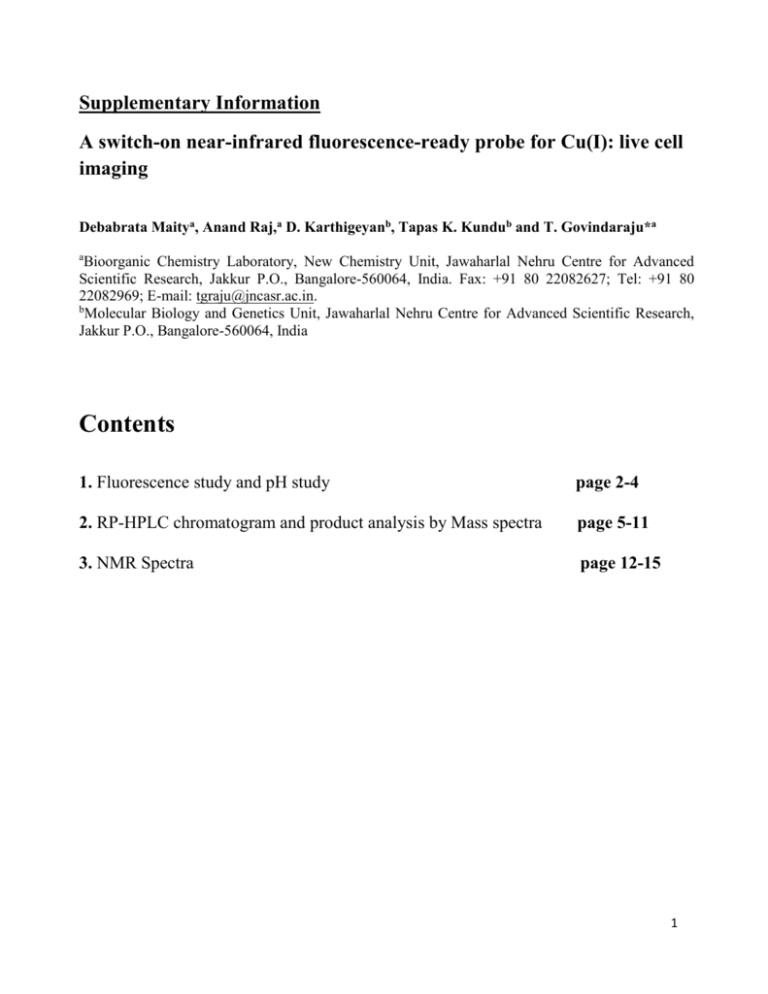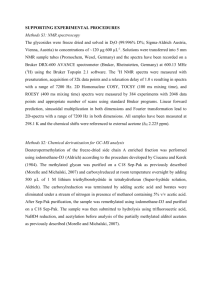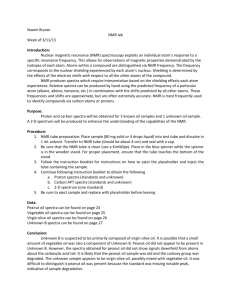2. RP-HPLC chromatogram and product analysis by Mass
advertisement

Supplementary Information A switch-on near-infrared fluorescence-ready probe for Cu(I): live cell imaging Debabrata Maitya, Anand Raj,a D. Karthigeyanb, Tapas K. Kundub and T. Govindaraju*a a Bioorganic Chemistry Laboratory, New Chemistry Unit, Jawaharlal Nehru Centre for Advanced Scientific Research, Jakkur P.O., Bangalore-560064, India. Fax: +91 80 22082627; Tel: +91 80 22082969; E-mail: tgraju@jncasr.ac.in. b Molecular Biology and Genetics Unit, Jawaharlal Nehru Centre for Advanced Scientific Research, Jakkur P.O., Bangalore-560064, India Contents 1. Fluorescence study and pH study page 2-4 2. RP-HPLC chromatogram and product analysis by Mass spectra page 5-11 3. NMR Spectra page 12-15 1 1. Fluorescence study and pH study Figure S1. Fluorescent responses of TPACy (20.0 µM) in 50 mM HEPES buffer (pH 7.2). The bars represent the fluorescence intensity at 700 nm after 2 h of reaction of 20.0 μM TPACy with different metal ion (20.0 μM) in the absence (dark gray bars) or presence (light gray bars) of 2 mM GSH (λ ex = 600 nm). 2 Figure S2. Time dependent fluorescence responses of TPACy (20.0 µM) upon addition of 20.0 µM of Cu+ in aqueous solution (50 mM HEPES, pH 7.2, 2 mM GSH) (λex = 600 nm). 3 Figure S3. Effect of pH on the fluorometric property of TPACy. Red trace: TPACy (20.0 μM) with 5.0 μM of Cu+ after 2 h in aqueous solution (50 mM HEPES, pH 7.2, 2 mM GSH). Black trace: TPACy (20.0 μM) in aqueous solution (50 mM HEPES, pH 7.2, 2 mM GSH). (λex = 600 nm). 4 2. RP-HPLC chromatogram and product analysis by Mass spectra Figure S4. RP-HPLC (grad. 10-100% ACN in water, 20 min.) of TPACy in aqueous solution (50 mM HEPES, pH 7.2, 2 mM GSH). 5 Figure S5. MALDI-MS spectra of the eluant fraction collected at 9.039 min in RP-HPLC (Fig. S4). Mass peaks observed at 1007.23 [M+H]+ is corresponds to TPACy. 6 Figure S6. RP-HPLC (grad. 10-100% ACN in water, 20 min.) of the reaction mixture of TPACy and Cu+ in aqueous solution (50 mM HEPES, pH 7.2, 2 mM GSH). 7 Figure S7. ESI mass spectra (positive ion mode) of the eluant fraction collected at 3.973 min in RPHPLC (Fig. S5). Mass peaks observed at 308 [M + H]+ is corresponds to glutathione. Mass peak at m/z = 613.0 ([M] +) was attributed to the oxidized form of GSH (GS–SG). 8 Calculated m/z for N4-Cu complex= 396.06 for C19H17CuN4O2 Figure S8. ESI mass spectra (positive ion mode) of the eluant fraction collected at 5.521 min in RPHPLC (Fig. S5). Mass peak at m/z = 396.0 ([M] +) is corresponds to TPA-Cu complex C19H17CuN4O2. 9 Calculated m/z for Cy-quinone = 703.89 for C38H43N2O7S2Figure S9. ESI mass spectra (positive ion mode) of the eluant fraction collected at 7.787 min in RPHPLC (Fig. S5). Mass peak observed at 705 was attributed to cyanine dye (Cy-quinone) (calculated for [C38H43N2O7S2− + H]+). 10 Figure S10. Proposed mechanism for Cu+/O2 mediated benzylic ether (C−O) bonds cleavage to release NIR emitting Cy-quinone dye. 11 3. NMR spectra 1H NMR spectrum of N4-O-bda 12 13C NMR spectrum of N4-O-bda 13 1H NMR spectrum of TPACy 14 13C NMR spectrum of TPACy 15



